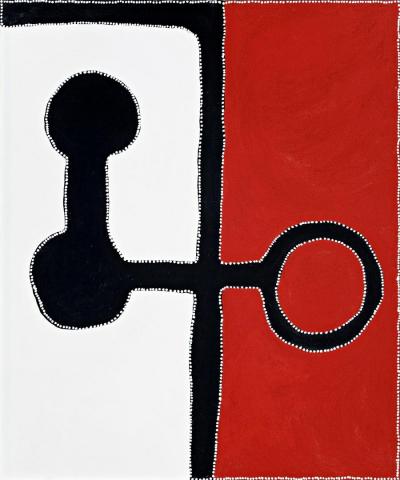JOOWARRINGAYIN - DEVIL DREAMING, 2000
Paddy Bedford
natural earth pigments and synthetic binder on linen
180.5 x 150.0 cm
signed verso: PB inscribed verso: Jirrawun Arts cat. PB32000.74
Jirrawun Aboriginal Arts Corporation, Kununurra
William Mora Galleries, Melbourne (stamped verso)
Private collection, Melbourne
Paddy Bedford, Museum of Contemporary Art, Sydney, 6 December 2006 - 15 April 2007
Storer, R., Paddy Bedford, Museum of Contemporary Art, Sydney, 2006, pp. 83 (illus.), 134 and 147 (illus.)
Paddy Bedford was a Gija man of the Jawalyi skin, born at Bedford Downs Station in the East Kimberley region of Western Australia. Bedford grew up on Bedford Downs where he began work as a stockman. After working on cattle stations for many decades Bedford, together with many indigenous station workers was forced to leave Bedford Downs in the early 1970s - an unintended consequence of the 1969 Pastoral Award legislation giving equal wages to indigenous and non-indigenous stockmen. Bedford moved to the Warmun Aboriginal community at Turkey Creek in the mid 1970s, and in 1998, began painting for the Jirrawun Aboriginal Arts Corporation (later Jirrawun Arts) established by Freddie Timms and Tony Oliver at Rugun (Crocodile Hole), 60 kilometers north of Warmun.
The paintings of Paddy Bedford further develop the manner and sparseness characteristic of the east Kimberley school. His initial use of ochre colours and bold forms contained in a defined structure, articulated by an outline of minimal dotting, echoes the early work of Rover Thomas and Freddie Timms. As his work evolved and his canvases became increasingly sparse, Bedford replaced the ochres of his early canvases with a simplified palette often using only black and white or black, white and a reddish brown, as employed in this work. In later works, his tonal range evolved to incorporate softer, more delicate hues, and further changed to explore more intense yellows, reds, blues and pinks.
Devil Dreaming, Joowarringayin is catalogued as painting 74 in Bedford’s chronological index of works. Completed in 2000, the painting depicts the site of Donkey Spring Devil Dreaming, Joowarringayin, located in the Leopold Range close to the old Elgee Cliffs Station and, according to the artist, the place of a “dangerous Devil Devil Dreaming".1 Located south-west of Bedford Downs, the area is characterised by a creek bed running between high, sheer cliffs and significantly, is associated with Bedford’s mother who was born nearby at Wirndoowoon.
It is important to note that the complex narratives in Bedford’s works intertwine family stories, historical events and a deep connection to his country, often masked by the simple, bold starkness of his technique. As curator Russell Storer observes, ‘his paintings articulate a complex dialectic between modern materials and traditional pictorial conventions, contemporary experience and ancient belief systems.’2
1. Storer, R., Paddy Bedford, Museum of Contemporary Art, Sydney, 2006 p. 134
2. ibid., p. 11
